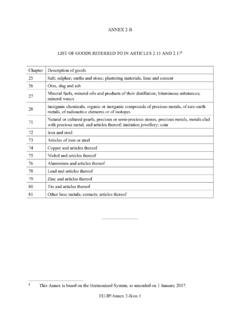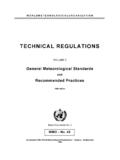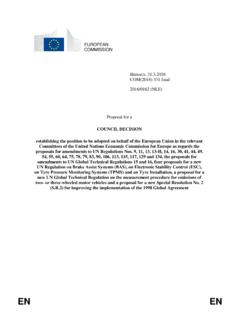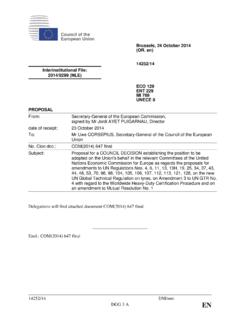Transcription of Regulation, Norms and Standards for medical products
1 1 | Regulation, Norms and Standards for medical products * Dr Lembit R go Head, Regulation of Medicines and other Health Technologies Essential Medicines and Health products World Health Organization Geneva, Switzerland E-mail: Technical Briefing Seminar 23-27 November, 2015 2 | Public health and medicines Availability and access to good quality, safe and effective medicines is a key contributor to achieving Public health objectives, Sustainable Development Goals and Universal Health Coverage To achieve global public health objectives functional and effective health systems are a must Ensuring quality, safety and efficacy of medicines is done by national and regional regulatory systems which are an integral part of health systems To be effective regulatory systems need tools science based quality Standards and regulatory guidelines.
2 These are needed for each single product, and more in general, also for manufacture and distribution 3 | Streamlining regulatory work in WHO HQ Director General HIS Cluster EMP Department RHT SAV RSS TSN PAU PHI (M. Chan) ( ) (C. Ondari) ( Kieny) (L. R go) (D. Wood) (Kees De Joncheere) (G. Forte) (Z. Mirza) (M. Macdonald) PQT 4 | Regulation of Medicines and other Health Technologies (RHT) unit (2013) Activities involve medicines, vaccines and other biological products , medical devices incl. in vitro diagnostics with 4 work streams/teams Technologies, Standards and Norms (TSN) Safety and Vigilance (SAV) Regulatory Systems Strengthening (RSS) Prequalification of medicines, vaccines and IVDs (PQT) 5 | Smell Appearance Taste Usual perceptions may not help in making judgements about medicines.
3 6 | Why medicines are special category of products ? Consumers, patients and (even) health care workers have limited capacity to judge there Q U A L I T Y S A F E T Y E F F I C A C Y In public perception "quality" may involve all three 7 | Are all medicines safe, effective and meet quality criteria? No, they are not Some are safe, but not effective or necessarily meet the quality criteria Some may be effective, meet quality criteria but are not safe Some meet quality criteria but are not necessarily safe or have any efficacy 8 | Are quality medicines always safe? Yes and No Some safety parameters are determined by quality these can be controlled by quality assurance Some safety parameters are determined by the intrinsic properties of active pharmaceutical ingredient(s) these cannot be controlled completely by any means, including risk management plans and other measurers For the last reason all medicines that are effective may have adverse reactions (virtually no 100% safe medicine does exit) 9 | What type of medicines we have?
4 (1) Single source originator products new medicines usually subject to IP and other exclusivity rights Multisource (generic) products usually after exclusivity rights expire, or other mechanisms are used to overcome these KEY INTERCHANGEABILITY, more important THERAPEUTIC INTERCHNGEABILITY ALL LITERATURE IS BASED ON ORGINATORS No interchangeability NEED FOR NEW SAFETY and EFFICACY DATA, NEW BOOKS HAVE TO BE WRITTEN 10 | What type of medicines we have? (2) Other type of products Biological products including vaccines and blood products , including "biosimilars" Advanced therapies - derived from gene therapy, cell therapy or tissue engineering. Radiopharmaceuticals.
5 Traditional (herbal) medicines Homeopathic medicines etc. 11 | What type of regulations exist and how they differ? For innovator products proof of QUALITY, SAFETY (pre-clinical and clinical) and EFFICACY (clinical) is needed For multisource (generic) products focus is on QUALITY, safety and efficacy data is referred to the originator product providing only evidence about therapeutic interchangeability (usually bioequivalence data in vivo, also certain cases in vitro comparative dissolution data) For traditional (herbal) medicines focus on quality and safety as efficacy may not be possible to prove 12 | Regulatory requirements for multisource (generic) medicines In short a generic medicine must.
6 (1) contain the same active ingredients as the innovator drug (2) be identical in strength, dosage form, and route of administration (3) have the same use indications (4) be bioequivalent (as a marker for therapeutic interchangeability) (5) meet the same batch requirements for identity, strength, purity and quality (6) be manufactured under the same Standards of Good Manufacturing Practice (GMP) as required for innovator products 13 | regulations : global , Regional vs National National regulations still differ a lot Especially for multisource/generic medicines What is International Conference on Harmonization (ICH) and what it is not? Originally designed for harmonizing regulatory requirements for NEW, innovative medicines between EU, US and Japan Recent news ICH is reorganized, more regulators governed, less industry dominant and more open to other regulators Regional harmonization initiatives EU fully harmonized, several other regions working on it Do global Norms exist for generics?
7 WHO has comprehensive set of Norms and Standards for regulating generic medicines 14 | Main medicines regulatory functions: all supported by different activities of WHO Licensing of the manufacture, import, export, distribution, promotion and advertising of medicines Assessing the safety, efficacy and quality of medicines, and issuing marketing authorization for individual products focus on generics and vaccines, assessing clinical trials Inspecting and surveillance of manufacturers, importers, wholesalers and dispensers of medicines Controlling and monitoring the quality of medicines on the market Controlling promotion and advertising of medicines Monitoring safety of marketed medicines including collecting and analysing adverse reaction reports Providing independent information on medicines to professionals and the public Source: WHO Policy Perspectives on Medicines no 7, 2003.
8 15 | Quality assurance of medicines not easy to understand, nor to "fly safe" 16 | Challenges of quality assurance increasing complexity of manufacture and supply chain Past M1a Current Pharmacies Hospitals .. APIs Excipients Packaging FPP M: Manufacturers/Suppliers Pharmacies Hospitals .. Packaging Wholesalers Distributors Wholesalers Distributors M1 FPP MX M1b APIs Mxa M2a M2 Wholesalers Distributors patients 17 | Why does quality matter? 18 | Example of contaminated active ingredient (see more at: ) 19 | New WHO quality test specifications to address the problem 20 | Common misconceptions Quality excessive reliance on certain isolated elements of regulatory systems quality control testing, without proper use of other regulatory tools and instruments as an integrated regulatory approach Quality can not be tested into the product, BUT It has to be built into it !
9 21 | Convergence and harmonization of regulatory requirements Objective of drug regulation: TO IMPROVE AND PROMOTE PUBLIC HEALTH Convergence and harmonization should aim to diminish duplicative efforts, creates "common language", facilitate cooperation and access to medicines In case of convergence and harmonization of regulations the main objective should be: MEASURABLE PUBLIC HEALTH GAINS There may be other gains, but these should be in the centre 22 | Regulatory Convergence and harmonization initiatives Inter-regional, regional and sub-regional ICH/IPRF, ICMRA, PIC/S, IGDRP, APEC, Pan American Network for Drug Regulatory Harmonization (PANDRH), ASEAN, AMRHI with EAC marching, SADC, ZaZiBoNa, Gulf Cooperation Council All not harmonized.
10 Good Harmonization and Convergence Practice (GHP) needed? Different organization with or without strong secretariat Different involvement of industries and other parties Different in terms of implementation some focused on implementation, others rather focused on convergence of regulatory thinking Different focus technical areas/ products .. 23 | Timely access to (hopefully) better medicines ladder Good Decision Making Practices Good Review Practices based on CTD, alignment and effective cooperation and worksharing Harmonization and convergence of technical requirements in conjunction with harmonized training principles and model core curricula for regulators Applicable modern laws and enabling legal system General Good Governance in Public Sector, including transparency and accountability 24 | Regulatory system strengthening for medical products first time system approach only in 2014!



















